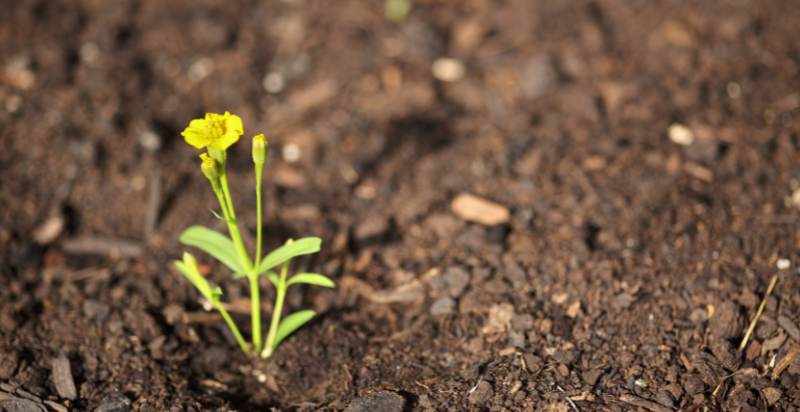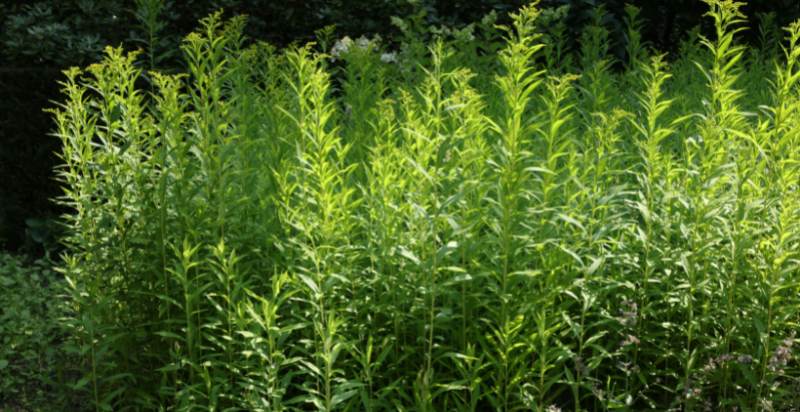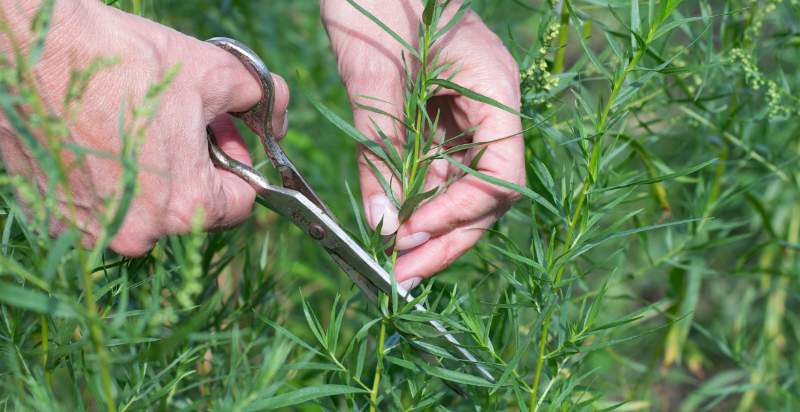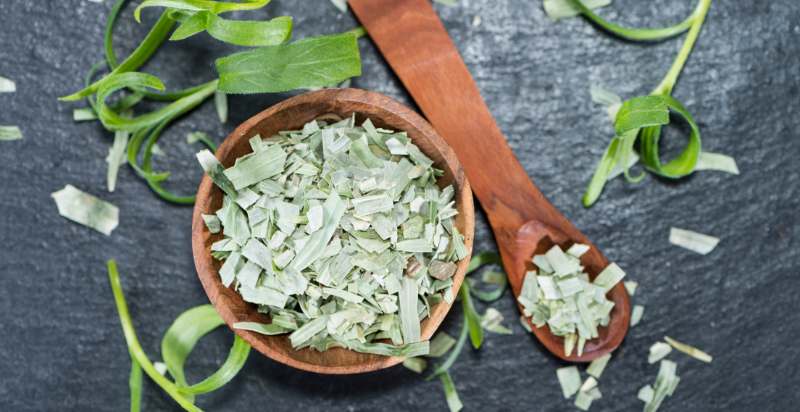Tarragon (Artemisia dracunculus) is a perennial herb belonging to the Asteraceae family. It is native to Eurasia and North America, growing best in temperate climates with well-draining soils. Tarragon has long been valued for its flavor and medicinal properties, though it can also be toxic when consumed in large amounts.
What is Tarragon?
Tarragon is a herbaceous perennial plant with an aromatic, somewhat sweet flavor. It has thin green stems and small yellow flowers. The leaves are lanceolate in shape and have a distinct anise-like aroma. The most widely cultivated tarragon is French tarragon (Artemisia dracunculus var. Sativa), which produces the best aromatic leaves for culinary purposes.
Types of Tarragon:
There are two main varieties of tarragon used for culinary purposes – French (Artemisia dracunculus var. Sativa) and Russian (A. dracunculoides). The French variety is the most widely cultivated and is considered the best in terms of flavor and aroma. It has a stronger anise flavor and is more expensive than the Russian variety, which has a milder flavor.
Description of Tarragon:
Tarragon has long, thin, bright green stems and can reach up to two feet in height. The glossy tarragon leaves have a slightly serrated edge, measuring between one and four inches in length. It produces small yellowish flowers from late spring through summer. The herb tastes somewhat sweet with an anise-like flavor.
Cultivation of Tarragon Plant:
Tarragon is best grown in well-draining soil and full sun. It can be propagated by seed, ( you can follow the same steps as with the oregano to propagate from seed ) cuttings, or division of existing plants. The herb prefers slightly acidic soil with a pH between 6.0 and 7.0. For best results, it should be planted in the spring or fall when the soil temperature is between 60-70 degrees Fahrenheit (15-21 Celsius). Tarragon should be harvested just before the flowering season begins to preserve its flavor and aroma.
Nutrition & Health Benefits of Tarragon:
Tarragon is an excellent source of vitamins and minerals, including vitamins A, B-6, C, E, and K. It also contains potassium, manganese, iron, and calcium. The herb has been used for centuries to treat various ailments, from digestive disorders to insomnia. It is believed to have anti-inflammatory and antioxidant properties and the ability to reduce fever and stimulate appetite. Tarragon can also be used to treat colds and stomach upsets.
How to Plant Tarragon?
Tarragon is an easy-to-grow herb with a unique flavor. It’s often used in French cuisine and makes an excellent addition to any garden or kitchen. Planting tarragon is fairly straightforward, and if you follow the steps below, you’ll have a fresh supply of herbs in no time!
Instructions
- Step 1: Choose the right location. Tarragon should be planted in an area that gets plenty of suns and is well-drained. If you’re planting directly in the ground, pick a spot that has access to water but isn’t prone to flooding.
- Step 2: Prepare the soil. Tarragon prefers rich soil with a pH balance between 6.0 and 7.5. To help the plant thrive, work some compost into the soil before planting your tarragon seeds or seedlings.
- Step 3: Plant your tarragon seeds or seedlings. When planting from seed, space each one about six inches apart and cover them lightly with soil. If you’re planting seedlings, space them at least 8 inches apart.
- Step 4: Water regularly. Tarragon should be kept moist but not oversaturated with water. Check the soil every few days and water it if it feels dry. Try to keep the leaves from getting wet when watering, as this can cause fungal diseases.
- Step 5: Harvest your tarragon throughout the season. When harvesting, cut off older stems and leaves first so that new growth can continue to form on younger stems. This will ensure a steady supply of herbs throughout the growing season!
With patience and careful preparation, you can grow a healthy crop of tarragon in no time. With its unique flavor and versatility, this herb will be a welcome addition to your garden or kitchen.

How to Care for Tarragon Plant?
Once you have planted your tarragon, it is important to maintain regular maintenance to ensure a successful harvest. Tarragon should be watered regularly, ideally about once a week or whenever the soil feels dry. Ensure not to over-water, as this can cause root rot and other diseases.
Fertilize your tarragon plants every 3-4 weeks using a balanced fertilizer such as 10-10-10. This will help promote healthy growth and increase yields. Additionally, prune back old or dead stems and leaves throughout the growing season to encourage new growth.
Finally, protect your tarragon from pests by applying insecticidal soap or neem oil if needed. These natural treatments control aphids, spider mites, and other small pests.
Following these simple steps, you can ensure that your tarragon plants remain healthy and productive throughout the growing season. With proper care, you can enjoy an abundance of fresh tarragon all summer!
Bonus Tip: To maximize your yields and ensure the highest quality herbs, it is best to harvest tarragon in the morning when temperatures are cool. This will help preserve its essential oils, which give the herb its distinct flavor and aroma. Additionally, discard any stems or leaves with signs of disease or pest damage before harvesting, as this can reduce yields significantly.

Preventions From Pests and Diseases:
To keep your tarragon plants healthy and productive, preventing pests and diseases from taking over is important. The best way to do this is by practicing good garden hygiene. Clear away weeds, debris, and fallen leaves from around your plants regularly to reduce the chances of pest infestations.
In addition, inspect your plants for signs of disease, such as discolored or wilting leaves. If you find any affected areas, prune them off immediately to help stop the spread of infection. You may also want to apply a fungicide or insecticidal soap if necessary.
Finally, use mulch around your tarragon plants to retain moisture and keep weeds at bay. This simple step can make a huge difference in the health of your tarragon and its ability to thrive. Choose an organic mulch such as pine needles or wood chips for best results.
How to Harvest?
Harvesting tarragon is easy and rewarding. Start harvesting your tarragon when the leaves become aromatic and flavorful, usually about 6-8 weeks after planting. If you want to extend the harvest further, plants can be cut back to 2 inches above the soil every few weeks. This will encourage new growth and ensure a continuous supply of herbs all season long!
When harvesting your tarragon, it is best to do so in the morning when temperatures are cool. The leaves should be cut off as close to the stem as possible using scissors or a knife. After picking, discard any stems or leaves with signs of disease or pest damage.

How to Store Tarragon?
Once you have harvested your tarragon, it is important to store it properly to preserve its flavor and freshness. For short-term storage, the best method is to wrap the leaves in damp paper towels or cloth and place them in a plastic bag. This will help keep the herbs moist and prevent wilting.
For long-term storage, tarragon can be frozen or dried for later use. To freeze tarragon, wash and dry the leaves before chopping them into small pieces. Place the chopped leaves on a baking sheet lined with parchment paper and freeze until solid. Once frozen, transfer them to an airtight container.
As for drying tarragon, hang bunches of stems upside down in a cool, dry location and leave them until the leaves are brittle. Then, store the dried leaves in an airtight container for up to one year.
How to Use Tarragon?
Tarragon is a versatile herb that can be used in various dishes. The leaves are often used fresh to add a distinctive anise-like flavor to salads, sauces, and egg dishes. It also pairs well with fish, chicken, and vegetables such as mushrooms or carrots.
In addition to fresh tarragon, the dried form can also be used. Dried tarragon is especially good for flavoring soups and stews or for making herbal teas.
As you can see, there are many ways to use tarragon in your cooking! Experiment with different recipes and combinations to find the ones best suit your tastes. With proper care and regular harvesting, you can enjoy fresh tarragon all season long!

Potential Risks From Tarragon:
Tarragon is generally safe to consume and does not typically cause adverse side effects. However, it contains small amounts of thujone, which can be toxic in large doses. Do not consume more than three grams of tarragon daily to avoid potential risk. Additionally, pregnant women should consult their doctor before consuming tarragon as there is a possibility that it could affect pregnancy hormones or the fetus.
Conclusion:
In conclusion, growing and harvesting tarragon is easy and rewarding! With proper care and regular harvesting, you can enjoy this aromatic herb all season long. Just remember to practice good garden hygiene, prevent pests and diseases from occurring, harvest your plants correctly, store them properly, and limit consumption. By doing so, you can enjoy tarragon’s flavor and health benefits without worrying about any potential risks.
Happy gardening!
- Everything You Wanted to Know About Red Tamarillos - June 2, 2025
- A Guide to Tulips: Everything You Need to Know & More… - June 2, 2025
- Guanabana: Description, Flavor, Benefits, And Uses - May 27, 2025

10 thoughts on “What Is Tarragon? Planting, Growing and Using the Tarragon Herb ”
Comments are closed.